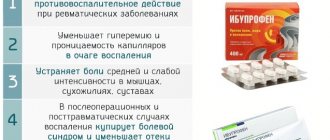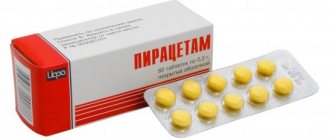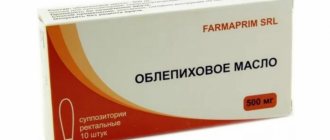Description
Trichopolum belongs to the group of antimicrobial drugs that are highly effective. The main component of this medication is metronidazole. The drug is available in the following forms:
- in tablets;
- in the form of a solution for infusion into the blood through a vein;
- in the form of vaginal tablets.
Trichopolum tablets contain 250 mg of the chemical, as well as additives such as magnesium, molasses, stearate, starch and gelatin. The finished drug is packaged in standard packages of 20 tablets each.
The solution contains the following components:
- metronidazole;
- water;
- sodium chloride;
- sodium hydrogen phosphate;
- citric acid monohydrate.
Additional information: Pharmacies sell ampoules with a dosage of 20 ml and bottles of 100 ml.
Special vaginal tablets trichopolum , in addition to the main chemical component (metronidazole - 500 mg), contain silicon dioxide, cellulose, povidone and stearic acid. Standard packaging – 5 or 10 pieces in standard packaging.
After metronidazole enters the body, the chemical penetrates the cell of the parasitic microorganism and destroys it. Its effectiveness has been repeatedly tested in the fight against anaerobic protozoa, as well as lamblia, trichomonas and gardnerella. The drug Trichopolum can be stored for up to 3 years at temperatures not exceeding 25 C.
Trichopolum 500 mg 10 pcs. vaginal tablets polpharma
pharmachologic effect
A drug with antiprotozoal and antibacterial effects for topical use in gynecology.
Composition and release form Trichopolum 500 mg 10 pcs. vaginal tablets polpharma
Vaginal tablets - 1 tablet:
- Active ingredients: metronidazole - 500 mg;
- Excipients: microcrystalline cellulose, povidone, crospovidone, colloidal silicon dioxide, stearic acid.
10 pieces. - blisters (1) - cardboard packs.
Description of the dosage form
Vaginal tablets are white with a yellowish tint, oblong, biconvex.
Directions for use and doses
For trichomonas vaginitis, the drug is prescribed 1 vaginal tablet per day for 7-10 days in combination with taking metronidazole tablets.
For nonspecific vaginitis and bacterial vaginosis, the drug is prescribed 1 vaginal tablet per day for 7 days, if necessary in combination with taking metronidazole tablets.
Treatment with metronidazole should not last more than 10 days and be repeated more than 2-3 times a year.
The vaginal tablet should be removed from the contour packaging, moistened with boiled cooled water and inserted deep into the vagina.
Pharmacodynamics
Antiprotozoal drug with antibacterial activity for topical use in gynecology. Refers to nitro-5-imidazoles. The mechanism of action of metronidazole is the biochemical reduction of the 5-nitro group of metronidazole by intracellular transport proteins of anaerobic microorganisms and protozoa. The reduced 5-nitro group of metronidazole interacts with the DNA of the cell of microorganisms, inhibiting the synthesis of their nucleic acids, which leads to the death of microorganisms.
Metronidazole is an effective antimicrobial and antiprotozoal agent with a broad spectrum of action. Shows high activity against Trichomonas vaginalis, Gardnerella vaginalis, Giardia intestinalis, Entamoeba histolytica, Lamblia spp., as well as against obligate anaerobes - Bacteroides spp. (Bacteroides fragilis, Bacteroides ovatus, Bacteroides distasonis, Bacteroides thetaiotaomicron, Bacteroides vulgatus), Fusobacterium spp., Veillonella spp., Prevotella spp. (Prevotella bivia, Prevotella buccae, Prevotella disiens) and some gram-positive microorganisms (Clostridium spp., Peptostreptococcus spp., Peptococcuc spp., Eubacterium spp., Mobiluncus spp.).
Pharmacokinetics
Metronidazole is well absorbed when administered intravaginally. Biotransformed in the liver. It is excreted 40-70% (about 20% in unchanged form) by the kidneys.
Indications for use Trichopolum 500 mg 10 pcs. vaginal tablets polpharma
For local treatment:
- nonspecific vaginitis;
- bacterial vaginosis;
- trichomonas vaginitis.
Contraindications
- blood diseases;
- leukopenia (including history);
- impaired coordination of movements;
- organic lesions of the central nervous system (including epilepsy);
- liver failure (for use in high doses);
- pregnancy (first trimester);
- lactation (breastfeeding);
- hypersensitivity to metronidazole or other nitroimidazole derivatives.
Application Trichopolum 500 mg 10 pcs. Polpharma vaginal tablets during pregnancy and breastfeeding
Metronidazole passes through the placenta, so the drug should not be prescribed in the first trimester of pregnancy. In the future, the drug should be used only if the potential benefit to the mother outweighs the possible risk to the fetus.
Metronidazole is excreted in breast milk. Breastfeeding should be discontinued during the period of use of the drug. Breastfeeding should be resumed no earlier than 48 hours after stopping the drug.
special instructions
It is recommended that the sexual partner be treated simultaneously with metronidazole, regardless of whether he or she has any manifestations of the disease.
During treatment with the drug, it is recommended to abstain from sexual intercourse.
If there are indications in the anamnesis of changes in the composition of peripheral blood, as well as when using the drug in high doses and/or during long-term treatment, monitoring of a general blood test is necessary.
Metronidazole may cause immobilization of treponemes, resulting in false-positive Nelson test results (TPI).
Impact on the ability to drive vehicles and operate machinery
The possibility of dizziness should be taken into account when prescribing the drug to patients engaged in potentially hazardous activities (especially vehicle drivers).
Overdose
Data on overdose of the drug Trichopolum are not provided.
Side effects Trichopolum 500 mg 10 pcs. vaginal tablets polpharma
Local reactions: itching, burning, pain and irritation in the vagina; thick, white, mucous vaginal discharge (odorless or with a slight odor), frequent urination; after discontinuation of the drug - development of vaginal candidiasis.
From the digestive system: nausea, changes in taste, metallic taste in the mouth, dry mouth, decreased appetite, abdominal cramps, nausea, vomiting, constipation or diarrhea.
From the side of the central nervous system: headache, dizziness.
From the hematopoietic system: leukopenia or leukocytosis.
Allergic reactions: urticaria, skin itching, rash.
Other: rarely - red-brown coloring of urine due to the presence of a water-soluble pigment formed as a result of the metabolism of metronidazole; a burning sensation or irritation of the penis in a sexual partner.
Drug interactions
The drug is compatible with sulfonamides and antibiotics.
Metronidazole causes ethanol intolerance, so alcohol should be avoided during treatment.
You should not combine metronidazole with disulfiram, since the interaction of these drugs may cause depression of consciousness and the development of mental disorders.
When used simultaneously with indirect anticoagulants (including warfarin), metronidazole enhances their effect, which leads to an increase in prothrombin time.
It is not recommended to use metronidazole in combination with non-depolarizing muscle relaxants (vecuronium bromide).
Under the influence of barbiturates, the effectiveness of metronidazole may decrease due to acceleration of its metabolism in the liver.
Cimetidine inhibits the metabolism of metronidazole, which can lead to an increase in its concentration in the blood plasma and an increased risk of adverse reactions.
When taken simultaneously with lithium preparations, it is possible to increase its concentration in the blood plasma.
Prescribed for men
Trichopolum for men is prescribed in the following cases:
- For alcohol addiction.
- If they are diagnosed with dangerous diseases such as pancreatitis, urethritis, gonorrhea or alantidiasis.
- For stomach ulcers and prostatitis of any type.
Before treating trichomoniasis, the diagnosis of the disease must be confirmed by taking and examining a smear.
Trichopolum for women
Instructions for use
's instructions for use present several options, the choice of which depends on the type of disease. Thus, Trichomonas is treated immediately in both partners, who are prescribed to take 1 tablet twice a day after meals. In addition, women are advised to administer suppositories once a day. The total duration of treatment is at least 10 days.
In case of ulcers, the drug is prescribed at a dosage of 250 mg and taken twice a day after meals. For vaginitis in women, doctors prescribe an increased dose - up to 1 gram per day, and for anaerobic infections - up to 1.5 grams. The course of therapy lasts in this case about 10 days and is carried out no more than 2-3 times a year.
Trichopolum in solution is prescribed in a dosage of no more than 1 gram and is administered intravenously over 30 minutes. The maximum permissible daily dose is 4 grams.
Interactions
Combinations that are not recommended
Disulfiram: Cases of psychiatric reactions (delirium, confusion) have been reported in patients taking metronidazole and disulfiram concomitantly.
Alcohol: Do not drink alcoholic beverages or take medications containing alcohol during treatment and for at least another 1 day after treatment due to the possible occurrence of a disulfiram-like reaction (Antabuse effect, hot flashes, erythema, flushing, vomiting, tachycardia) .
Busulfan: Metronidazole may increase plasma levels of busulfan, which may result in significant busulfan toxicity.
Combinations that should be used with caution
Oral anticoagulant therapy (warfarin): increased anticoagulant effect and increased risk of bleeding caused by decreased hepatic catabolism. In case of simultaneous use, prothrombin time should be monitored more often and anticoagulant therapy should be adjusted during treatment with metronidazole and for 8 days after its discontinuation.
Trichopolum does not interact with heparin.
Fluorouracil: decreased clearance of fluorouracil and increased toxicity.
Lithium: Plasma lithium levels may increase when taking metronidazole. Plasma lithium, creatinine, and electrolyte concentrations should be monitored in patients taking lithium and metronidazole concomitantly.
Cyclosporine: risk of increased plasma levels of cyclosporine. If the drugs must be coadministered, cyclosporine and creatinine levels should be carefully monitored.
Phenytoin or phenobarbital: causes a decrease in metronidazole plasma levels.
Change in international normalized ratio (INR): Numerous cases of increased activity of oral anticoagulants have been reported in patients receiving antibiotic therapy. In this case, risk factors that determine the tendency to such a complication are the presence of infections or severe inflammation, age and general health. Under these circumstances, it is difficult to determine how much the INR imbalance is affected by the infection itself or its treatment. However, some classes of antibiotics play an important role in this, in particular: fluoroquinolones, macrolides, cyclines, trimoxazole and some cephalosporins.
Contraindications and side effects
Trichopolum tablets are strictly forbidden to be used to treat children under 3 years of age, as well as pregnant women. It is recommended to stop breastfeeding a child while taking the medication for the duration of treatment. Contraindications for use are:
- Severe liver and kidney diseases.
- Epilepsy in all manifestations and forms.
- Nervous system disorders.
- Leukopenia and allergic reactions.
During the course of treatment with Trichopolum, side effects affecting some of the patient’s organs cannot be ruled out. Deviations are accompanied by disturbances in the functioning of the esophagus (a bitter taste appears in the mouth), as well as severe headaches, blurred vision, impaired coordination and dizziness.
In some cases, there is a decrease in the content of platelets and red blood cells in the blood, as well as local reactions, manifested in severe itching, burning and increased urination. To avoid side effects during treatment, you must completely abstain from alcohol in any form and sexual intercourse.
Side effects
From the gastrointestinal tract: epigastric pain, nausea, vomiting, diarrhea, inflammation of the oral mucosa (glossitis with dry mouth, stomatitis, coated tongue), taste disorders, anorexia, isolated cases of pancreatitis, which are reversible.
From the skin and its derivatives: rash, itching, skin flushing, urticaria, fever, angioedema, anaphylactic shock, pustular rash, hot flashes with hyperemia, erythema multiforme, Stevens-Johnson syndrome, toxic epidermal necrolysis, sometimes febrile manifestations, discoloration of the tongue , “hairy tongue” (due to excessive development of fungal flora).
From the nervous system: ataxia, drowsiness, headache, convulsions, dizziness, encephalopathy (for example, confusion, increased body temperature, increased sensitivity to light, torticollis, hallucinations, paralysis, visual and movement disturbances); aseptic meningitis, sensory peripheral neuropathies or transient epileptic seizures, dysarthria, gait disturbance, nystagmus, tremor.
From the organ of vision: temporary visual impairment, such as diplopia, myopia, decreased visual acuity, changes in color perception, optical neuropathy/neuritis, photosensitivity.
From the psyche: mental disorders, including confusion, depressed mood, hallucinations.
From the blood and lymphatic system: agranulocytosis, neutropenia and thrombocytopenia, pancytopenia, leukopenia.
From the hepatobiliary system: increased activity of liver enzymes (AST, ALT, ALP), cholestatic or mixed hepatitis and liver cell damage, sometimes jaundice; liver failure requiring liver transplantation in patients taking metronidazole in combination with other antibiotics
Other adverse reactions: increased body temperature.
During treatment, urine may acquire a red-brown color, which is due to the presence of water-soluble pigments, which are products of metronidazole metabolism.
Analogues and cost of Trichopolum
In the absence of Trichopolum, it can be replaced with drugs of similar composition, such as, for example, Efloran, Flagyl, Gravagin, Metrogyl and Metronidazole.
The price of Trichopolum varies depending on the form in which it is produced. Tablets will cost the user at least 85 rubles, and vaginal suppositories - from 333 rubles.
Please note: Trichopolum is usually not sold in solution.
In conclusion, we note that the drug in question has a wide range of action, relatively low price and proven effectiveness. However, when taking it, side effects are possible, manifested in a bitter taste in the mouth and mild intestinal disturbances. In any case, you must first consult with a therapist.
Note!
Description of the drug Trichopolum table. vagina. 500 mg No. 10 on this page is a simplified author’s version of the apteka911 website, created on the basis of the instructions for use.
Before purchasing or using the drug, you should consult your doctor and read the manufacturer's original instructions (attached to each package of the drug). Information about the drug is provided for informational purposes only and should not be used as a guide to self-medication. Only a doctor can decide to prescribe the drug, as well as determine the dose and methods of its use.











